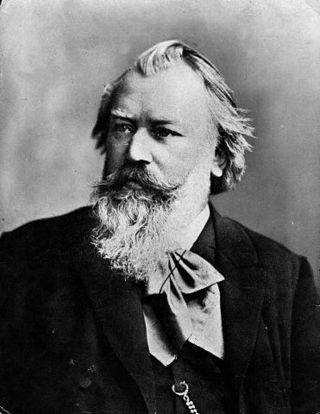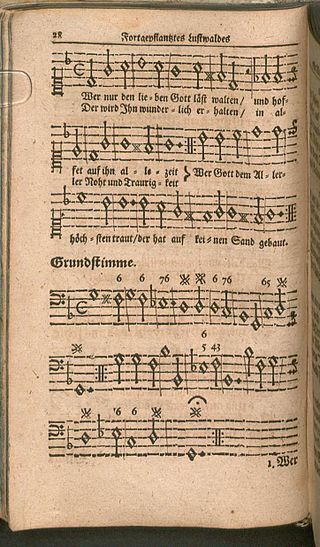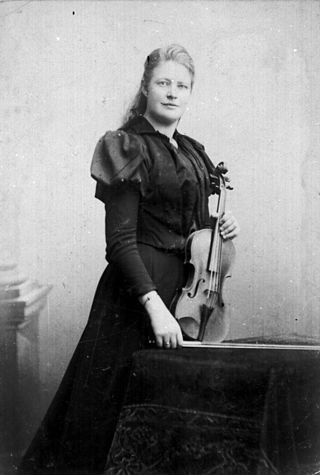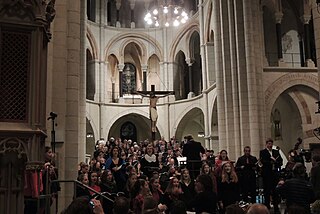
Johannes Brahms was a German composer, pianist, and conductor of the mid-Romantic period. Born in Hamburg into a Lutheran family, he spent much of his professional life in Vienna. He is sometimes grouped with Johann Sebastian Bach and Ludwig van Beethoven as one of the "Three Bs" of music, a comment originally made by the nineteenth-century conductor Hans von Bülow.

Clara Josephine Schumann was a German pianist, composer, and piano teacher. Regarded as one of the most distinguished pianists of the Romantic era, she exerted her influence over the course of a 61-year concert career, changing the format and repertoire of the piano recital by lessening the importance of purely virtuosic works. She also composed solo piano pieces, a piano concerto, chamber music, choral pieces, and songs.

Joseph Joachim was a Hungarian violinist, conductor, composer and teacher who made an international career, based in Hanover and Berlin. A close collaborator of Johannes Brahms, he is widely regarded as one of the most significant violinists of the 19th century.

The Piano Concerto No. 1 in D minor, Op. 15, is a work for piano and orchestra completed by Johannes Brahms in 1858. The composer gave the work's public debut in Hanover, the following year. It was his first-performed orchestral work, and his first orchestral work performed to audience approval.
Variations on a Theme of Paganini, Op. 35, is a work for piano composed in 1863 by Johannes Brahms, based on the Caprice No. 24 in A minor by Niccolò Paganini.

A German Requiem, to Words of the Holy Scriptures, Op. 45 by Johannes Brahms, is a large-scale work for chorus, orchestra, and soprano and baritone soloists, composed between 1865 and 1868. It comprises seven movements, which together last 65 to 80 minutes, making this work both Brahms's longest composition and largest ensemble-work. A German Requiem is sacred but non-liturgical, and unlike a long tradition of the Latin Requiem, A German Requiem, as its title states, is a Requiem in the German language.
The "War of the Romantics" is a term used by some music historians to describe the schism among prominent musicians in the second half of the 19th century. Musical structure, the limits of chromatic harmony, and program music versus absolute music were the principal areas of contention. The opposing parties crystallized during the 1850s. The most prominent members of the conservative circle were Johannes Brahms, Joseph Joachim, Clara Schumann, and the Leipzig Conservatoire, which had been founded by Felix Mendelssohn. Their opponents, the radical progressives mainly from Weimar, were represented by Franz Liszt and the members of the so-called New German School, and by Richard Wagner. The controversy was German and Central European in origin; musicians from France, Italy, and Russia were only marginally involved.

The Variations and Fugue on a Theme by Handel, Op. 24, is a work for solo piano written by Johannes Brahms in 1861. It consists of a set of twenty-five variations and a concluding fugue, all based on a theme from George Frideric Handel's Harpsichord Suite No. 1 in B♭ major, HWV 434. They are known as his Handel Variations.
The two Serenades, Op. 11 and 16, represent early efforts by Johannes Brahms to write orchestral music. They both date from after the 1856 death of Robert Schumann when Brahms was residing in Detmold and had access to an orchestra.
The F-A-E Sonata, a four-movement work for violin and piano, is a collaborative musical work by three composers: Robert Schumann, the young Johannes Brahms, and Schumann's pupil Albert Dietrich. It was composed in Düsseldorf in October 1853.
The Horn Trio in E♭ major, Op. 40, by Johannes Brahms is a chamber piece in four movements written for natural horn, violin, and piano. Composed in 1865, the work commemorates the death of Brahms's mother, Christiane, earlier that year. However, it draws on a theme which Brahms had composed twelve years previously but did not publish at the time.

Neue Liebeslieder, Op. 65, written by Johannes Brahms, is a collection of Romantic pieces written for four solo voices and four hands on the piano. They are also known as Neue Liebesliederwalzer. Neue Liebeslieder were written during the Romantic period between 1869 and 1874. The text of the songs is adapted from folk songs of various areas of Europe including Turkey, Poland, Latvia and Sicily. The text for songs 1 through 14 were translated and compiled by Georg Friedrich Daumer in his poem series, Polydora; the text for the fifteenth and final song, entitled "Zum Schluß", was written by Johann Wolfgang von Goethe.

Johannes Brahms composed his Piano Trio No. 2 in C Major, Op. 87, between 1880 and 1882. It is scored for piano, violin and cello. He wrote this piece at the age of 49.
Johannes Brahms' String Sextet No. 2 in G major, Opus 36 was composed during the years of 1864–1865 and published by the firm of Fritz Simrock. It was first performed in Boston, Massachusetts on October 11, 1866, with the European premiere following the next month in Zurich.

"Wer nur den lieben Gott läßt walten" is a 1641 hymn by Georg Neumark, who also composed the melody for it. It has seven verses and deals with the Christian putting their trust in God. Its author referred to it as a "Trostlied" or song of consolation and it first appeared in his Fortgepflantzer musikalisch-poetischer Lustwald. It also appeared in Johann Crüger's 1672 Praxis pietatis melica and in the first part of Johann Anastasius Freylinghausen's 1704 Geistreiches Gesangbuch. It has inspired musical settings, and is part of current German hymnals, both Protestant and Catholic.

Amanda Röntgen-Maier was a Swedish violinist and composer. She was the first female graduate in music direction from the Royal College of Music in Stockholm in 1872.
The Concerto, BWV 525a, is a trio sonata in C major for violin, cello and basso continuo, based on material otherwise found in Johann Sebastian Bach's first Organ Sonata, BWV 525, and Flute Sonata in A major, BWV 1032. The oldest extant manuscript containing the BWV 525a arrangement, D-B Mus.ms. Bach St 345, is dated to the middle of the 18th century. Although this version of Bach's sonata movements may have originated during his lifetime in the circle around him, it seems unlikely that the composer supervised, or even ordered, the manufacture of the string trio adaptation, thus the arrangement has been listed in BWV Anh. II, that is the Anhang (Anh.) of doubtful works, in the 1998 edition of the Bach-Werke-Verzeichnis (BWV). Breitkopf & Härtel published BWV 525a in 1965. Digital facsimiles of 18th- and 19th-century manuscript copies of the arrangement, in which the sonata is titled "Concerto", became available in the 21st century.

Laudato si' is an oratorio composed in 2016 by Peter Reulein on a libretto by Helmut Schlegel. Subtitled Ein franziskanisches Magnificat, it includes the full Latin text of the Magnificat, expanded by writings of Clare of Assisi, Francis of Assisi and Pope Francis. The composer set it for five soloists, children's choir, Choralschola, mixed choir, symphony orchestra and organ. It was published in 2016 by the Dehm Verlag, and was premiered on 6 November 2016 at the Limburg Cathedral, conducted by the composer.

Lord, have mercy upon us, WoO. 12, MWV B 27, is the incipit of a motet for choir a cappella in both English and German composed by Felix Mendelssohn in 1833. It is also known in English as Responses to the Commandments, and in German as Zum Abendsegen. It was published in 1842, both in English and German, and by Breitkopf & Härtel in 1875 in the complete edition of the composer's works.
Joachim Draheim is a German musicologist, music teacher and classical pianist.












